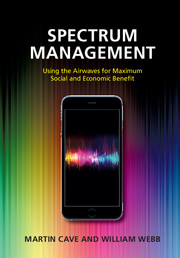Book contents
- Frontmatter
- Contents
- Preface
- Acknowledgments
- Plan of the book
- List of abbreviations
- Part I Fundamentals
- 1 Spectrum management around the world
- 2 The technical challenge
- 3 The economic challenge: a basic primer on spectrum economics
- Part II Economic management of spectrum
- Part III Sharing and other emerging approaches to spectrum management
- Part IV Case studies and conclusions
- About the authors
- Index
- References
3 - The economic challenge: a basic primer on spectrum economics
from Part I - Fundamentals
Published online by Cambridge University Press: 05 November 2015
- Frontmatter
- Contents
- Preface
- Acknowledgments
- Plan of the book
- List of abbreviations
- Part I Fundamentals
- 1 Spectrum management around the world
- 2 The technical challenge
- 3 The economic challenge: a basic primer on spectrum economics
- Part II Economic management of spectrum
- Part III Sharing and other emerging approaches to spectrum management
- Part IV Case studies and conclusions
- About the authors
- Index
- References
Summary
The radio spectrum is a resource of great significance to all modern economies. The importance of services supported by radio spectrum has grown markedly in recent years, especially as more and more mobile communications applications take hold among the world's population. It is thus critical that this increasingly important resource is allocated efficiently, in a way which maximizes the benefits which people gain from their individual use of services such as mobile telephony or broadcasting, or which they gain collectively from the availability of spectrum using public goods such as defense.
The aim of this chapter is to set out the requirements for efficient use of spectrum and, in particular, to show how methods of spectrum management based on the use of markets or price-type instruments can help in this goal.
Characteristics of spectrum as an economic resource
Spectrum can be viewed as if it were a finite resource, in the sense that in a given frequency band within a specific location there will be a physical limit to the amount of use possible. In this regard a frequency band is analogous to land – its location and area is given but its productive capability is dependent upon technology. Radio spectrum is heterogeneous, as different frequency bands are suited to different purposes, as is illustrated in Table 3-1, although there is scope to some degree for substitution of one band for another in certain uses.
Unlike oil or gas, it is not storable: if a band is not utilized over any period the opportunity to use it can never be recovered. Equally, it is not exhaustible: it cannot be depleted or used up. It has to be used in its existing location or not at all; there is no possibility of importing or exporting it.
More can be got out of spectrum in two ways: first, by bringing into use bands which have not been used before; in the case of land, where this is also true, this has been known as the “extensive margin.” Equally, as also with land to which fertilizer is applied, spectrum can be made more efficient by such things as compression techniques, which increase efficiency on what can be called the “intensive margin.”
- Type
- Chapter
- Information
- Spectrum ManagementUsing the Airwaves for Maximum Social and Economic Benefit, pp. 42 - 60Publisher: Cambridge University PressPrint publication year: 2015



